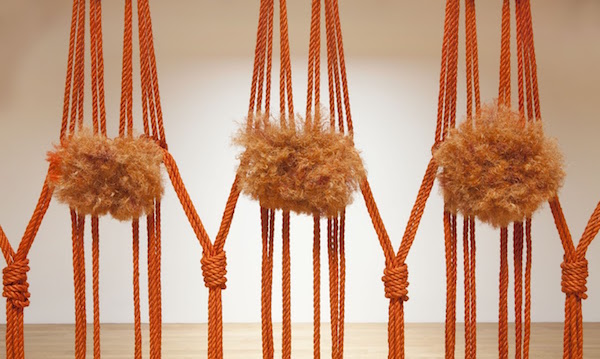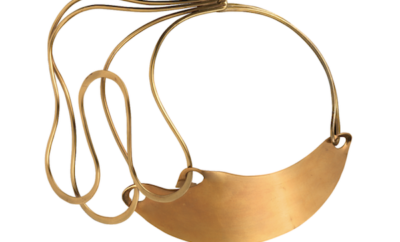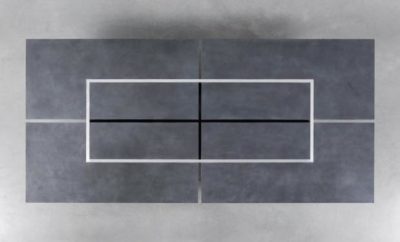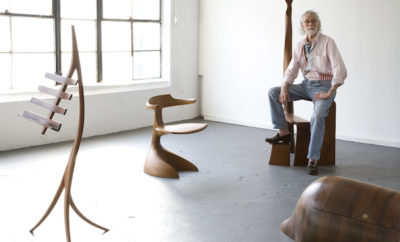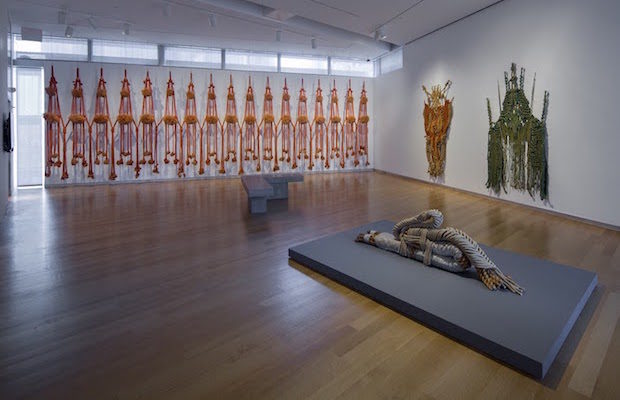
Exhibition
Françoise Grossen Selects: Fiber Art that is Truly Off the Wall
When entering the gallery space for Françoise Grossen Selects, at the Museum of Arts and Design in New York, you feel the thrill that comes from encountering something beautiful but not entirely tame. With five large hanging pieces, two sculptural forms, and a collection of maquettes, constructions, and samples, which New York-based Grossen produced between 1967–1987, the exhibition draws attention to the transformation and accompanying freedom that occurred as her tapestry was liberated from the loom and enriched by new materials such as wide piping cord and rubber. While she developed a virtuosity with fiber techniques and knots, reaching back to the artistry of ancient civilizations, she became interested, as fellow fiber artist Claire Zeisler had been, in the gravity drawing her threads down to the floor. The show, which closes on March 15, also includes fiber work, large (Tomoko Ishida’s ethereal paper and starch Co-twisted) and small (Arline M. Fisch’s sensuous copper and silver cuffs), that Grossen has chosen wisely and graciously from the museum’s collection as a complement to her own accomplishments.
Fifty years ago, Grossen, who trained in textile art and weaving, began to work with off-loom techniques, knotting and plaiting wool and sisal. As she experimented—her hands constantly in touch with the threads—basketry patterns began to appear on her surfaces, loops and openings broke through, and her tapestries developed ridges and whorls-like dense skins. She then suspended her finished pieces further from the wall and they became three dimensional, casting shadows that moved and changed and might be seen from all directions. Breaking from the confines of traditional rectangular frames, some of her work began to bear semblance to totemic figures or shields with their abrasions, threads, and braids as they magically floated through space.
Grossen is best known for her meticulous knots and braids, her Havana twists (sometimes the thickness and weight of gym climbing rope), and cables with fringed ends. In the 1970s and early 1980s, these pieces were commissioned to decorate spare, concrete Brutalist architecture. Contact III, a massive hanging piece made from manila rope with looped together triangular sections, extends across an entire interior wall of the current exhibition. An earlier version, as she puts it, “with seven elements holding hands,” was once hung from a string stretching across a narrow street in Tribeca. With a bridge in the background, the piece became interactive, almost mirroring the urban landscape. While Contact III brings to mind the repeated geometry in indigenous art—you might even see the rope forms as a band of connected figures—its radiant mandarin color pops out around contrasting balls of tufted fiber, a joyous visual joke.
Like choreographers in the 1970s, Grossen was interested in taking her work off the pedestal, allowing it to spread or even flop on the floor, in nature, or in urban environments. She originally created her 20-foot-long Inchworm in cotton industrial piping cord. Later, she translated the form into rubber tubing with cork so it could float across the surface of a pond. The rubber hose maquette on view looks like an enlarged house centipede with woven bands along its trunk and lavish, curling legs. Her later rope pieces often seem like lyrical metaphors for the human form. Embryo, with cables folded back and forth on top of each other like tucked legs, is something like a concrete poem constructed from rope and wrapping material.


